Phil the Spill
Phil gives us a clue to how he came by his nickname.
1) NSU Quickly 'N' (49cc) February 1974. Basic model of the moped range. Step through with bulbous tank (about 1 gallon) and tasteful tartan panniers! Three speeds - gear change via left hand twist grip - and, like some bicycles, back pedalling put the rear brake on.
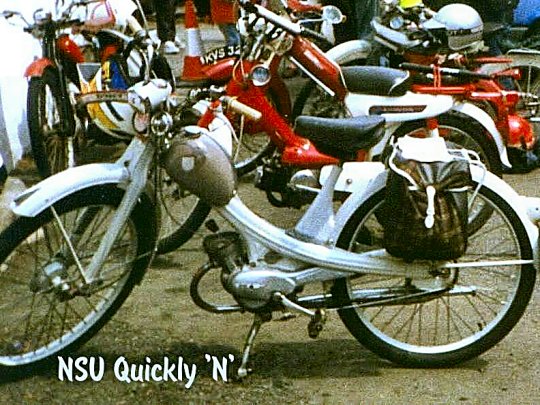
Speedo had been removed, but that was allowable back then. (If it had one it HAD to work.) Must have been of 1950s construction - like me! It cost £6 from a neighbour, but needed new tyres before it had a chance of being ridden anywhere. When I got it, there was hardly any power coming out of the engine. This was caused by the carb needle being slightly out of alignment, wearing the aperture a little too large, making the mixture hopelessly rich. Once replaced, it was quite a nippy little beast. One day the rear end supports fell victim to old age and collapsed while I was pootling about. I sold it to a Quickly collector shortly after that, (the same one that sorted out the carb problem).
2) Honda SS50 (49cc) September 1974. Original 4-speed model. It did have pedals, which could (after much fiddling and skinned knuckles) propel the vehicle (legal requirement to be classed as a moped) - but this could seriously damage the knees, so was not advisable.
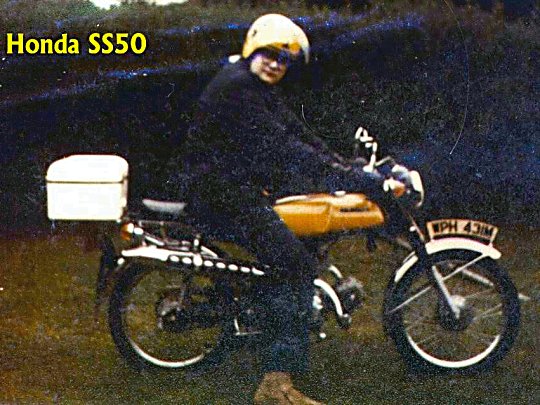
As a four-stroke, it had far less power than the similar-looking Yamaha FS1-E (originally called SS50 as well), but was far quieter. Spent most of the time looking for steep hills to run down, hoping to get over 30mph. Written off after an encounter with a French driver in a hurry.
3) Honda C70 (72cc) 20 May 1977. Need I say more?
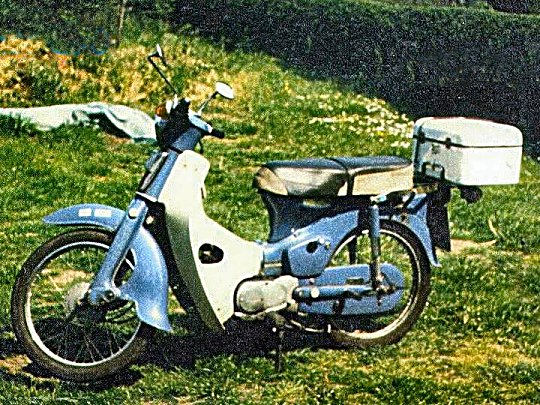
Passed my bike test on this, (Yes, this was how we did it back then - one-part test on anything over 49cc), on the second attempt - on the first attempt the plug lead managed to snap on the way to the test centre. Had a few crunches, and a tendency to snap exhaust pipes. Eventually it seized. I had it rebored and sold it fairly rapidly after that.
4) Yamaha XS250 (248cc) 5 May 1977 - 28 July 1980.
Unremarkable bike. The original tyres were more suited to a combo, being almost square sectioned. This caused 'much hilarity' amongst my fellow club members on a late night run to the coast, when I was unable to take a corner at speed, going straight on and ending up inches from a plate-glass window on a (closed) garage forecourt. This gained me the name 'Phil the Spill' although I did not actually crash on that occasion. Subsequent events meant I was never able to get rid of the name, and I have now embraced it. I did my first rally on it.
So I was on my Yamaha XS250, merrily chugging along towards the cinema at Ewell, in Surrey, for a night of biker-related films, (Peter Fonda, mostly). As I approached a side road, a car lurched out of the pub car park, straight in front of me. The bike hit the car, (try opening that door!), and I flew over the bonnet and head-butted a keep left bollard. Turns out the driver was not drunk, he was heading home because his medication was making him a bit tired.
Last Crash of Red Baron IV
This was quite a while after I got the name 'Phil the Spill', but it was my first serious crash since then.
It ended painfully. [1 rally]
5) Yamaha XJ650 (653cc) 6 August 1980 - June 1984. Must have been the fastest '650' on the road at the time. Quicker than many 750s as well. After the original exhaust gave way to rust, I replaced it with an ALFA 4-into-1. This was probably not intended for normal road use, as the noise level was more than likely illegal. When prompted it could eject a huge orange flame with an ear-splitting backfire on the overrun. This, combined with the fact that it was a good few inches shorter than the original, meant that the throw-over pannier could melt in the blast even in normal running. I managed to get a fantail deflector, more usually fitted to flash customised cars, to prevent this. It needed replacing after disappearing down the M6 after a rally.
On this bike I started having fun with fairings, (I did have a screen on the C70 for a while), starting with a small 'Vetter - Quicksilver' item. They, being an American company, made the fairings for the US variants of the bikes. The US XJ650 didn't have an oil cooler bolted to the frame, so they had to specially design a curved bracket for my bike. The major niggle I had with it, (apart from the electrics), was the airflow, which directed all rain water up onto my wrists. After another off, this had to go, so I upgraded to a full-sized 'Pantera'. This was fine until the ditch incident. Going home across Chobham Common from work one night, I thought a large dark animal crossed the road in front of me - possibly the infamous Surrey Panther - while considering this, I completely forgot the T-junction at the bottom of the hill - the bike somersaulted into a ditch, dumping me on the road, whereupon most of the mounting points snapped off.
Still managed to get to Shetland with it on, but it was held together by multiple bungees by the time I got home. Replaced that with another of the same, which lasted until the bike's gear selector fell apart one day, so I transferred the fairing to the BMW and then sold the bike. [77 rallies 18.5 per annum]
6) Yamaha RS200 (198cc) November 1983. Bought off my sister as a back-up bike. Very nearly a 'binary-clutch' (very little give - either on or off).
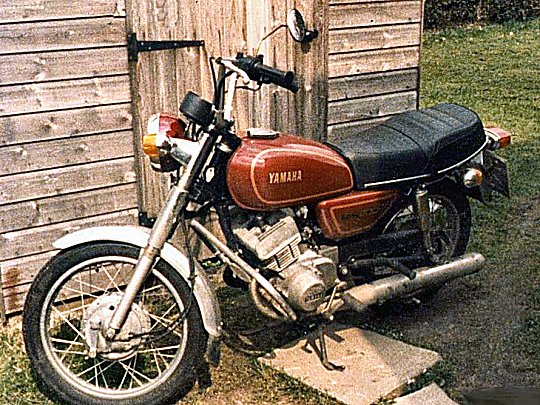
After THE accident (of which, more later) this was the bike that got me back on the road (much to my doctor's disgust). After a period of disuse, the rusty chain snapped when I used it one day. [2 rallies]
7) BMW R65 (649cc) 18 April 1984 - 9 October 1985. One of the unpopular ones with the 'hinged' frame. Needed a decent-sized bike for all the rally luggage following the demise of the XJ.
A few weeks after transferring the fairing from the Yam, another SMIDSY led to me having to take it all off again a two days before the Shetland run.
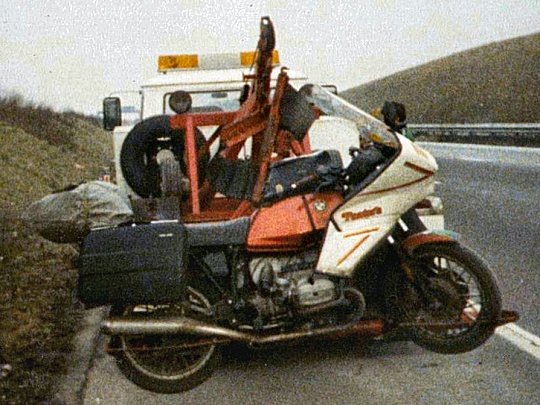
Four months later an exhaust valve fell apart - holed the piston. [33 rallies 22 p.a.]
8) BMW R80RT (797cc) 7 October - 1 November 1985. Decided I wanted a properly designed fully-faired bike. Never even made it to a rally. It would have done one, but I noticed the pin striping on one section of the fairing was upside-down, so the shop whipped it away to re-paint it.
Had to use the 200. Check the dates - that's right - it lasted all of three weeks.
A car driver decided he wanted to turn right onto a side road, but couldn't wait for me to clear the junction first. My second flying lesson - much further than the first - ended with me head-butting a tree. Bike written off, along with three of my vertebrae. The shop did a little swap-around, transferring the loan details to the next bike.9) BMW R80RT (797cc) 24 February 1986 - 31 July 1988. Undaunted, I tried again (after recovering).
It was while I had this one that the above-mentioned RS chain snapped, (in TWO places!) Two years after the Prowlers rally my previous bike missed, due to the paint issue, I was heading to the latest Prowlers. I was following a car through some S bends, when a car coming the other way decided that it was the ideal place to overtake the car in front of them. The car in front of me swerved off the road, but still got hit, sending the offender into a spin straight at me. I threw the brakes on, (admittedly not a good thing to do when cornering a loaded bike), so the bike fell over and pinned me to the road in the path of the car, which stopped just as it touched my helmet. The drunk driver was trying to accelerate madly away, despite having lost a wheel.
Nine months later, after another shunt, (car stopped - I stopped - two cars behind me didn't), the bike was declared written-off, even though it was still - just about - ride-able. [53 rallies 22.1 p.a.]
10) BMW R100RT (980cc) 1 August 1988 - 15 May 1994. This time, I decided to join the one-litre 'club' and then discovered I missed it by 20cc. Bullet-proof engine, but not road/pavement proof cylinder heads. (Another story - totally unconnected with the ultimate demise of this one.)
This was, to date, my longest surviving bike and so I had no reason to think that the gearbox would blow up, as it did, on the way from the Lake District, (after a Shetland rally), to the Norman Rally in Hastings. Loud noise and a lot of shaking on the M6 indicated all was not well down below. Third and fifth gear disappeared, (common shaft, I believe), along with most of the gearbox oil. Topping up seemed to help and I managed to get to Hastings using 1st, 2nd and 4th gears only. I would have happily made it all the way home after the rally, but more noise and loud grinding in any gear put paid to that plan and I called out the RAC. Obviously the gearbox needed replacing, which was really annoying, as I had just bought a house and money... well, you know, but it had to be done.
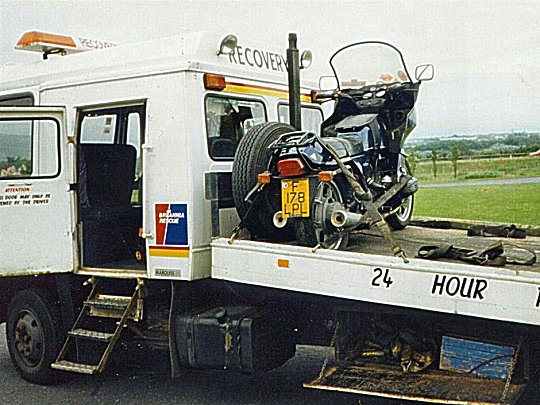
Less than a year later - guess what! There is a crossroads/roundabout junction near where I lived that has three lanes going in each direction. You can, just about, turn right into another direction if you are in the right-hand lane. I was in that lane but going straight ahead - also allowed. A driver in the centre lane decided that she (sorry - but true!) decided that she could turn right from her lane without the bother of using indicators.
My only personal injury was bruising from my knuckles to my shoulder of my left arm, but the bike was a bit too bent to survive. [95 rallies 16.5 p.a.]
10a) This was only a couple of weeks before the Shetland run and choosing a new bike can be a drawn-out process, so I had to hire a bike for the Simmer Dim. A nasty Honda V4 thing was all the local shop could loan me, as all the Gold Wings were booked. It took me there and back, but the racing crouch didn't agree with my back at all. Also, I had to keep the speed below 110mph as the throw-over luggage started flapping about too much for comfort. [1 rally]
11) Norton Commander (588cc) 1 July 1994 - 6 July 2007. NOT A COMMANDO! This is one of the Rotaries - 1989 vintage. Hugely enjoyable. Hardly any engine vibration. Very fast.
I was always intrigued by rotary engines and I was convinced that, having only one moving part, there was less to go wrong (hmm...). After having a test ride of one on Shetland, (nearly killing myself in the process while discovering what 'no engine braking' actually felt like), I decided I really wanted one. When I discovered one for sale while looking for a replacement for the BMW, I knew it was meant to be. (I was so close to getting a Kawasaki GTR1000!)
I got it at the time when the country was changing over to unleaded petrol. My BMWs disliked the stuff, so I was still on 4-star. It was just by chance that I found the Norton would run on unleaded, but I switched over happily, as the price differential was quite steep.
Although it is demonstrably only 588cc, the fact that there are three power 'strokes' per revolution - 6 on a twin - means the racing authorities didn't like rotaries. The Norton racer, (same engine throughout the range - only different gearboxes), was occasionally classed as a 1500! But insurance companies go by engine size alone, so it was classed as less than 600.
The main body of the bike was Norton, but the front end was entirely Yamaha XJ900 (except the fairing), as was the rear wheel, so that it matched. The final drive was by totally-enclosed oil-bath chain.
It was similar to a two-stroke in that it consumed oil with the petrol, even though there were about 10 different grades of oils used at various points of the machine, the main tank was straight SAE40, preferably of the Shell 'Rotella-X' brand (due to low-ash characteristics). Of course, they stopped making this in the 90s, so I had been using diesel-engine-designed straight 40 from local car shops but then someone near to me, although I had never seen him on the road, sold their Norton and had about 100litres of 'Rimula.X' (which was the nearest version available).
The design of the electrics left something to be desired. The fairing was open to the elements below so, if the road was wet, water got thrown up straight at the ignition coils. This is what always got me when it was raining - not the rain itself, but the surface water.
There were two batteries, (showing its Police bike origins), mounted either side of the main oil tank.
There was also a thermistor circuit, which allowed more fuel to get to the engine when it was cold, for easier starting. Trouble is, when it got hot, so little was getting through that the engine would stall and refuse to start again for some time. The workshop solution, after trying several (expensive) modifications, was to simply take it out. This didn't make it noticeably more difficult to start in the cold, but once running, less embarrassing.
Once there was a problem with fluctuating voltage boiling the batteries - the original spec did not include a regulator.
The bike needed a ballast resistor to reduce the electricity when the bike was running, as opposed to full power when starting. The original design had this deep in the depths of the fairing. The former owner (a Baron of Runnymede) had extended the connecting wires and bolted the thing to the frame, where it could be accessed. (I needed to replace this only once - apparently the only other vehicle that used this type was a Ford Transit.
The plugs were cleverly placed in the narrow gap between the radiator and the engine block. This would have meant a complete dismantling if the workshop had not given me a sawn-off swan-necked spanner, which just fitted in, meaning the plugs could be extracted, albeit with skinned knuckles, for (frequent) cleaning/replacement.
The fixed panniers were slightly smaller than I would have liked, and a little smaller on the inside than they appeared, because they housed the immense array of rear lights, (from, of all things, a Vauxhall Nova!) There were what appeared to be pockets in the fairing, but one just covered the fuse array and the other the radiator reservoir cap. Both were, therefore, also open to the ground. I bought a large enough tank bag, the one I originally had on the BMWs was not the right shape for the tank, which had large magnets to anchor it in place. There was no metal in range on the Norton, having a one-piece fibreglass covering, but the weight of the magnets helped support the straps I threaded under the seat at the rear, and into the fairing at the front, to attach to the frame.
Starting problems arose and worsened and eventually this reluctance to start, even with fully charged batteries, meant it got too unreliable. Repeated trips to the workshop were too expensive and I even tried the patience of a fellow Rotarian. I still had over 50 litres of the oil left over, sold it with the bike. Still my longest-lasting bike, and my furthest travelled - 77,000 miles, but not so many rallies. [47 rallies 3.6 p.a.]
12) Kawasaki EN500 (498cc) 1997. Had to buy it from a friend after crashing it while borrowed during one of the Notrun's many rebuilds. Fixed it up OK, but then left it standing during my six-month ban, (totting-up 12 points), following the aforementioned crash. Couldn't get it working after that, so I sold it. Managed to get the Notrun working instead. [1 rally]
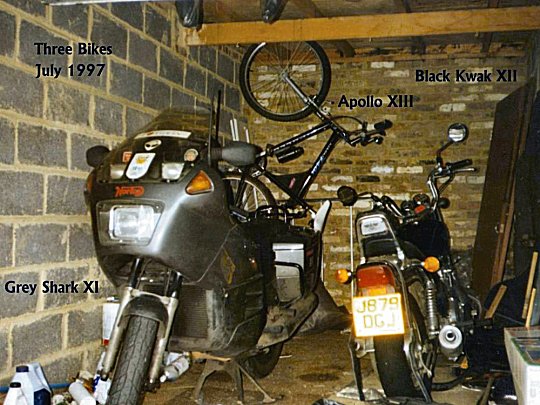
13) Apollo Stealth (0cc) 1997 - I'm not generally superstitious (touch wood) but I claim my bicycle - used while banned - as my 13th vehicle. I donated it to my stepson, after his own got nicked, but he left it behind when he moved to Dundee, so I have it back again.
14) Honda CB250 (243cc) 14 November 2002 - 22 July 2007. Used as a second bike during my Notrun ownership (that didn't like 5-mile commutes). To be honest, possibly used more than the Notrun - even went to a few rallies (one in Derbyshire) on it.
Reliable enough, even though I did have to replace the exhaust on it. A strange thing to remember, but it came with the most stable and sturdy top-box I can ever remember having. [2 rallies]
15) Honda Deauville 700 (680cc) 27 July 2007 - 16 October 2011. Got this and sold the other two in roughly running (running roughly) order.
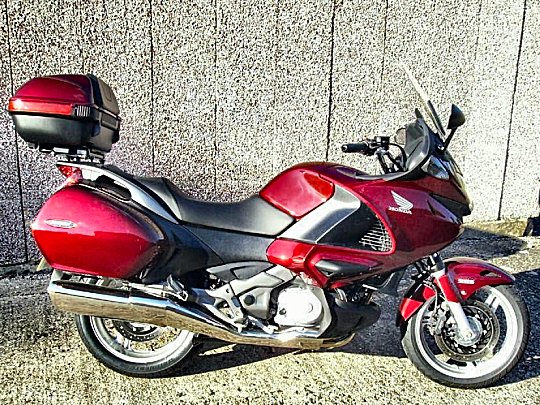
I had a removable top-box fitted (even sturdier than the 250!), and it came with fixed panniers. I invested in the deeper lids, which almost doubled the capacity. I kept the originals as well, so I could switch to 'narrow mode' when not carrying much. I also got pannier bags to ease the carrying of luggage to & from the bike. The front fairing pockets, (only one had a lock on it), proved to be next to useless, and I still used the tank bag that I bought for the Norton. Now, however, the magnets were of some use!
Sold it when it got to be sitting in the garage for months at a time and it eventually got too painful to ride. [4 rallies]
I have only owned two four-wheelers. I bought and sold a Ford Transit Ambulance, which had been converted to a camper. The CB250 fitted neatly in (=wedged when driven into) the gap between the bench seats.
Then I bought a proper camper, a Home-Car PR62, which is sitting outside our house at the moment. I have been allowed to use this at the last two GPO rallies, even though there is nowhere to fit a motorbike.
Phil Drackley - Phil the Spill